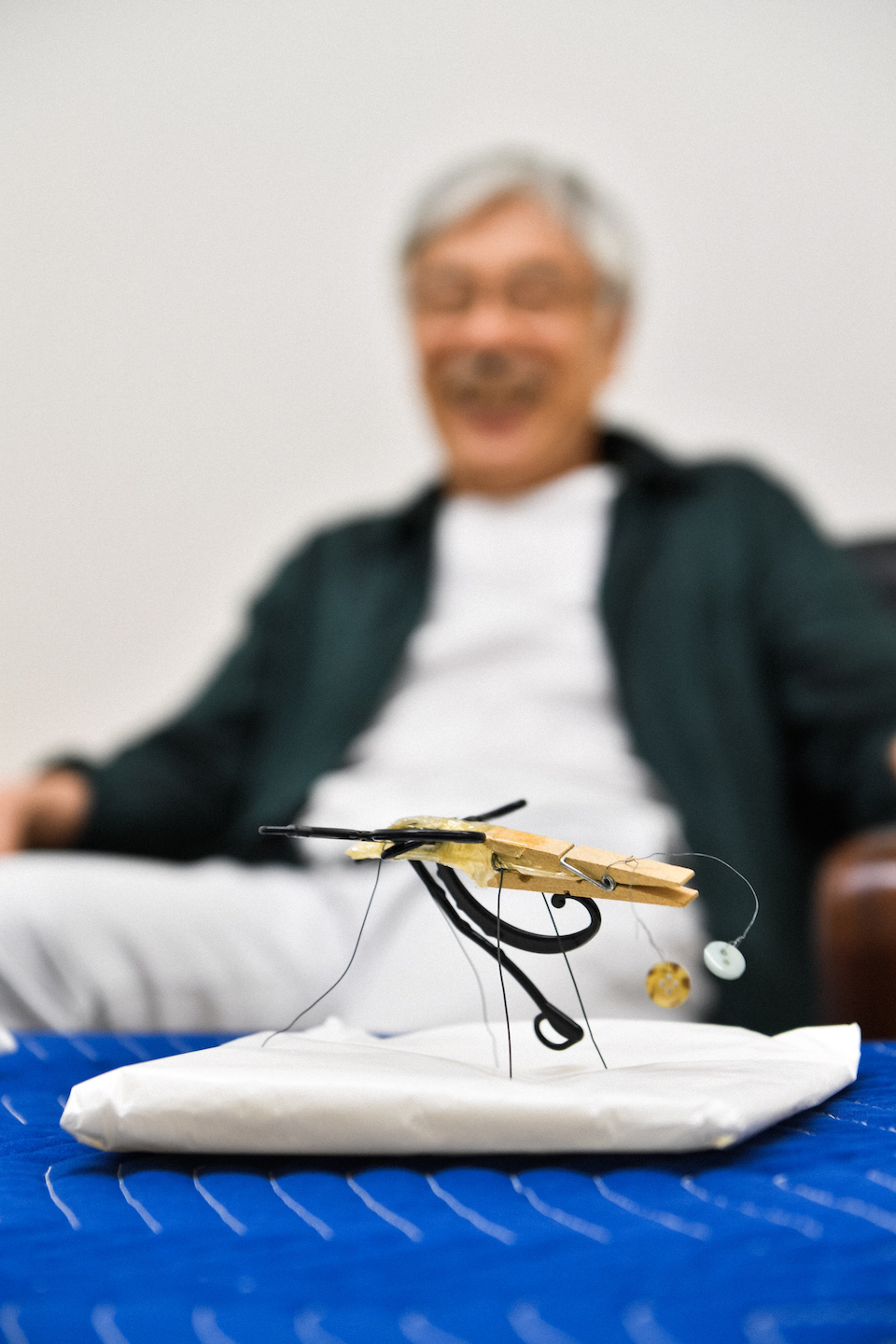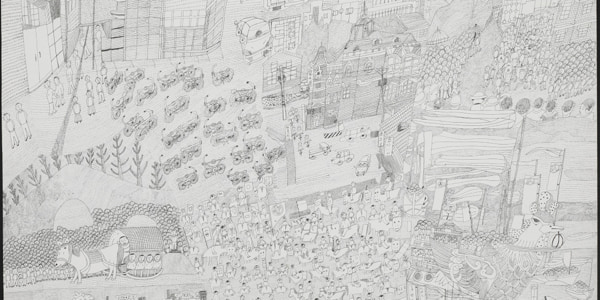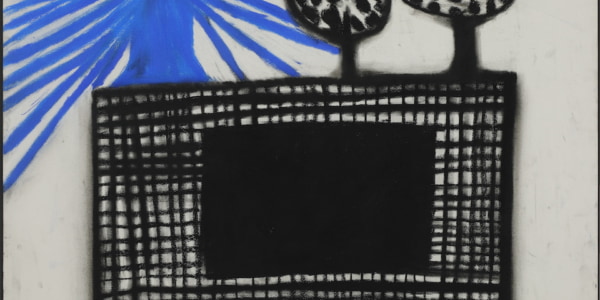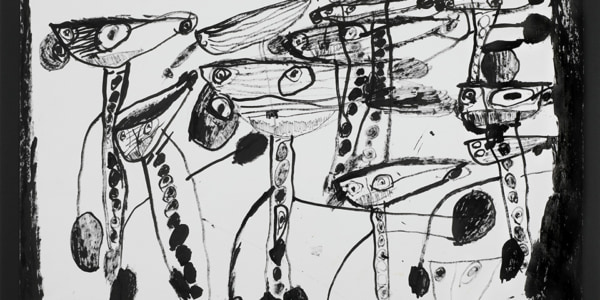Co-starring
YASHIMA Koichi (1963-)
Yashima was born in Osaka Prefecture. He creates sculptures by using cellophane tape to combine items he finds along the way from his home to a center he visits. He has exhibited in a variety of events, including the Museum of Together exhibition (2017, Spiral Garden, Tokyo), the Sei no Kokuinten exhibition (2018, the Tokushima Modern Art Museum), and Life and Creation exhibition (South Observation Deck of Tokyo Metropolitan Government Building). He currently is not engaging in creative activities.
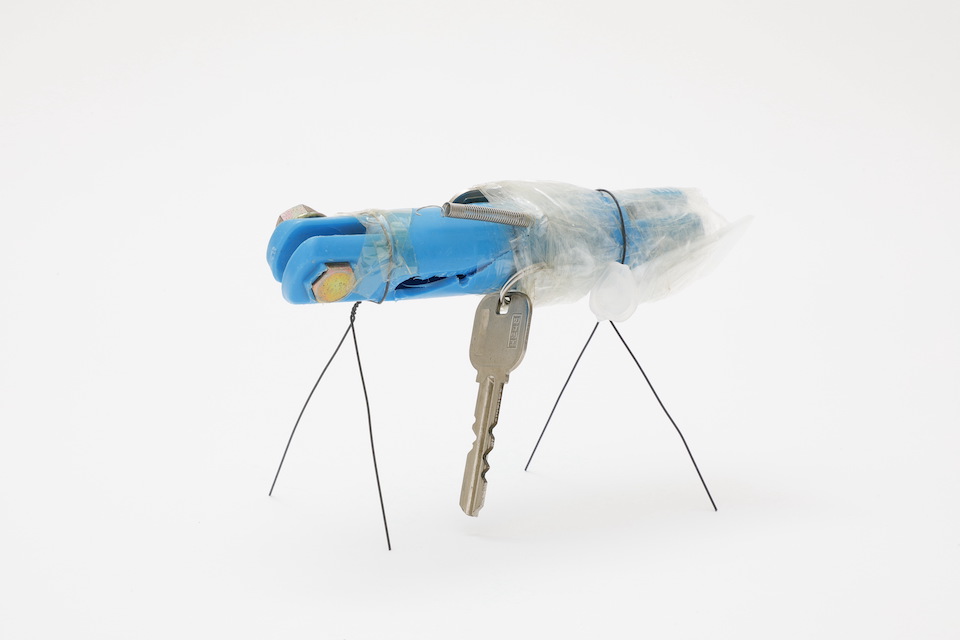
“Grasshopper” / 150×120×45mm / Key, screw (metal), spring, wire, plastics, cellophane tape / 1998 / Collection of The Nippon Foundation
What is this? Why, it’s a device which uses grasshopper legs to scratch on a windowpane and make noise. It makes a terrible, screeching, squeaking sound.
Actually, these three things were made before the grasshopper.
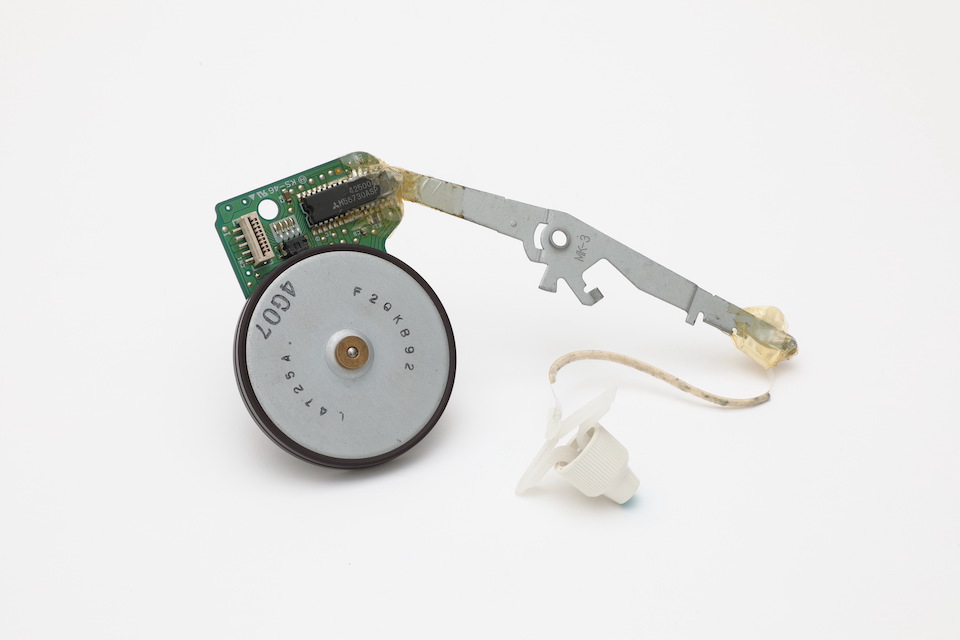
“Untitled” / 320×100×45mm / Electronic components, cap (plastic), cellophane tape / 1998 / Collection of The Nippon Foundation
This round thing rotates and cuts glass.
When the disk rotates, it cuts out a round piece of glass.
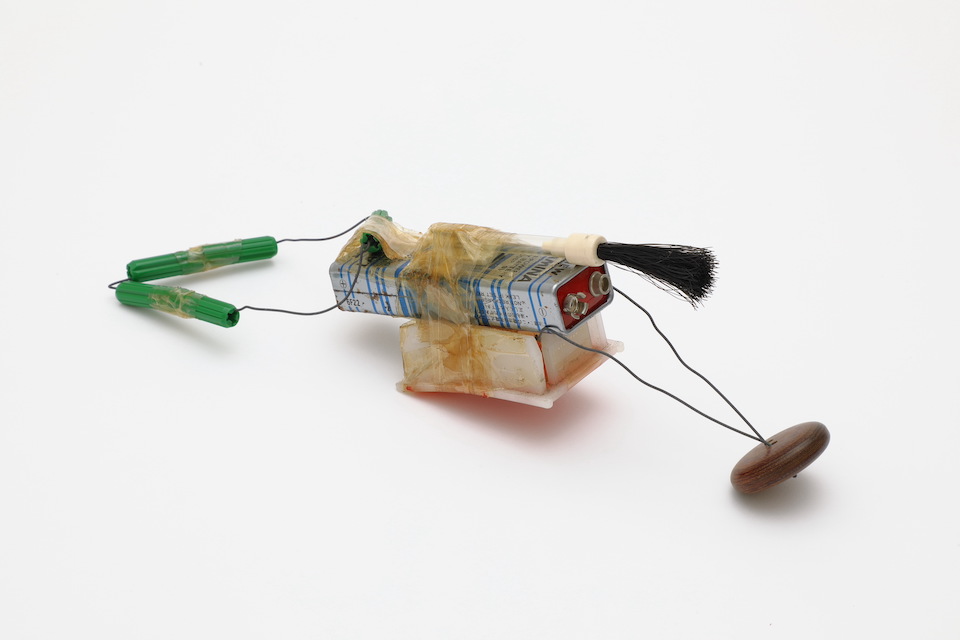
“Crab” / 240×65×55mm / Batteries, button (wood), wire, oil-based ink, plastics, cellophane tape / 1998 / Collection of The Nippon Foundation
And this one pulls the other two along. When they arrive at their target point with the help of this one, the round one climbs onboard an airplane and cuts out glass with a whirring sound. And then the other one cleans up the scraps, you see.
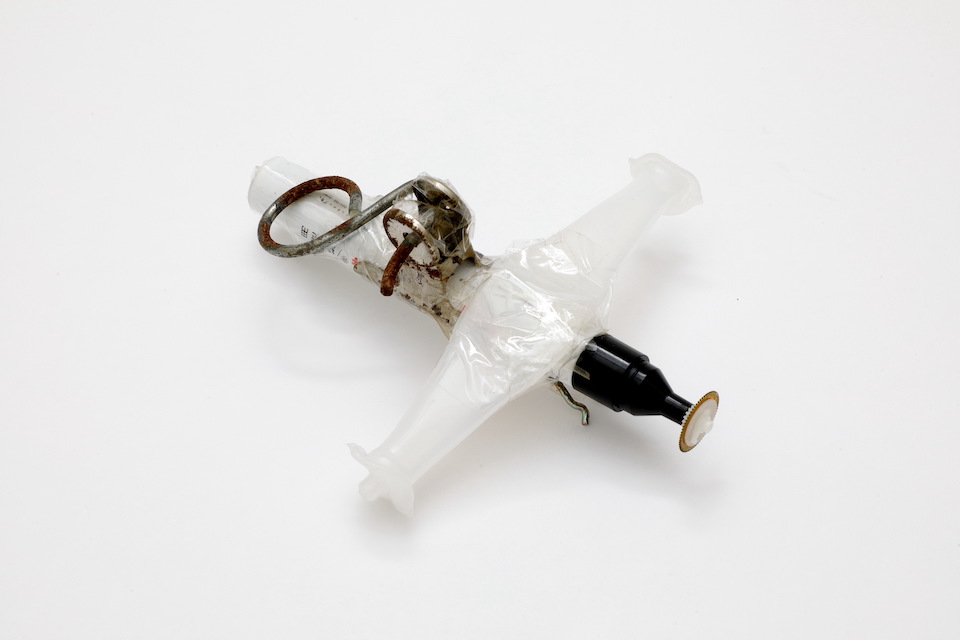
“Airplane” / 130×120×50mm / Permanent marker, clip (steel), wire, metal, gear (plastic, metal), plastics, cellophane tape / 1998 / Collection of The Nippon Foundation
These machines were built during the height of the Nazi occupation of Poland. They were invented by a resistance fighter, a scientist being hunted down by the Nazis and working in secrecy. They were designed to be used to help uncover what Hitler and Nazi Germany were planning. If the resistance could learn of their plans, they could move first and obstruct them. So these devices were made for an operation which involved cutting holes in conference room windows to listen in on the information being discussed during meetings.
However, while the plan worked up to listening in on meetings, the resistance members couldn’t understand what Hitler and the Nazi leadership was saying. Why? Because the resistance members were Polish and spoke the Polish language, and they couldn’t understand the German spoken by Hitler and the other Nazi leaders.
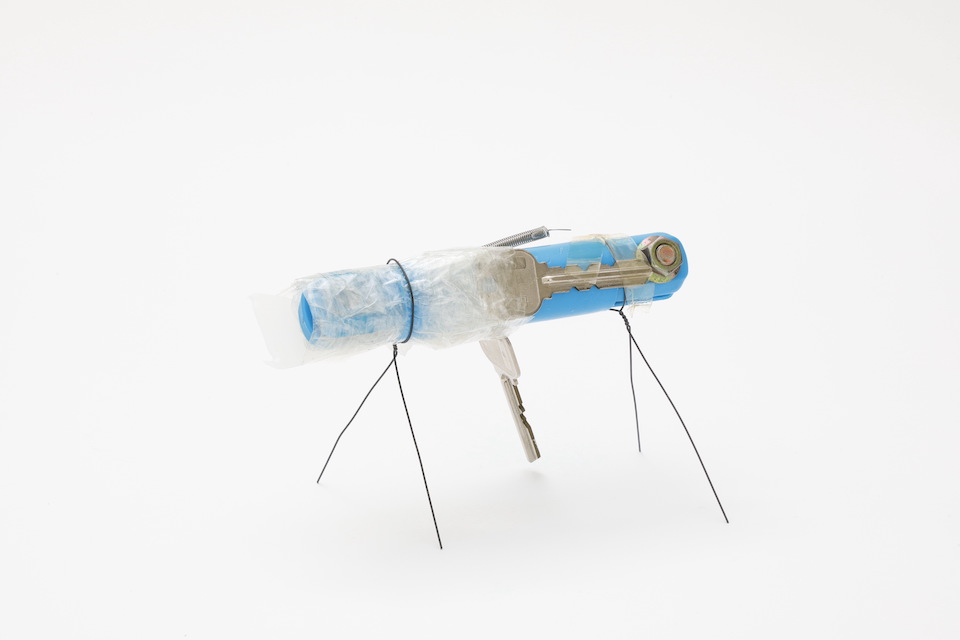
“Grasshopper” / 150×120×45mm / Key, screw (metal), spring, wire, plastics, cellophane tape / 1998 / Collection of The Nippon Foundation
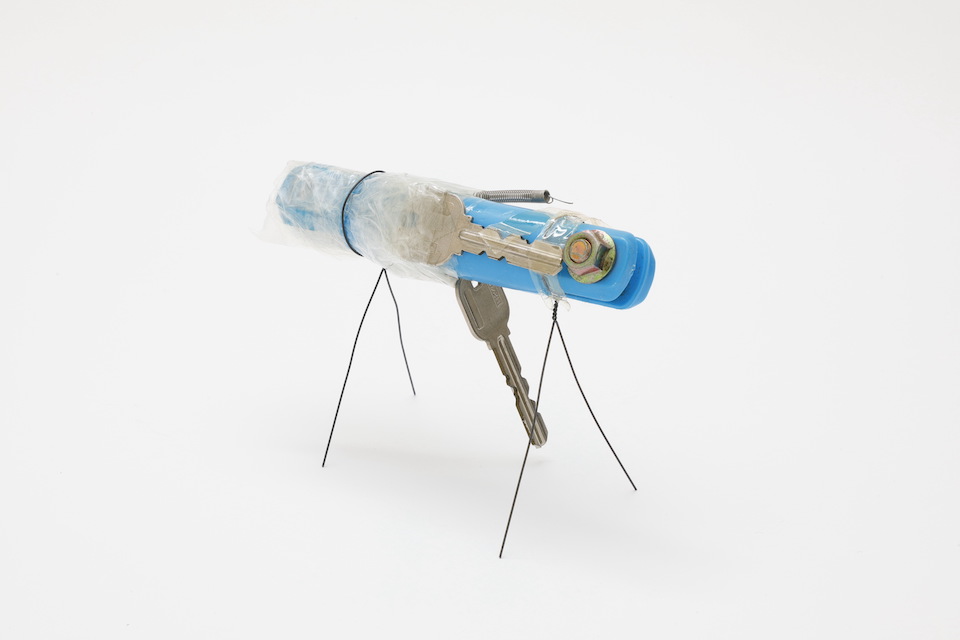
“Grasshopper” / 150×120×45mm / Key, screw (metal), spring, wire, plastics, cellophane tape / 1998 / Collection of The Nippon Foundation
A Polish resistance scientist was dead serious about this idea. It would make an awful screeching sound, preventing Hitler and his subordinates from concentrating. The reason why it has keys attached to it is perhaps based on the idea that the device could use them to get inside buildings. The reason why there are two, I suppose, is one for the entrance and one for the exit, haha.
This operation went well at first. Windowpane Scratchers made noise that was just awful, and so meetings couldn’t proceed at all.
But the noise made by the Windowpane Scratchers was so bad, the Nazis eventually moved to basements. And there they held meetings in rooms with no windows, resulting in the Windowpane Scratchers no longer being useful.
With the operation no longer being effective, the resistance called a halt to it. And production of Windowpane Scratchers was also stopped.
During the few years up until the operation was ended, tens of thousands of Windowpane Scratchers were made. Because they didn’t know where Hitler was, Windowpane Scratchers were released into every building they could find, and they crawled up and down the windows of all sorts of buildings.
And during those years, the Windowpane Scratchers began to evolve of their own accord. They gained a will of their own, and their tactile senses grew more sensitive, so that now they were able to detect danger.
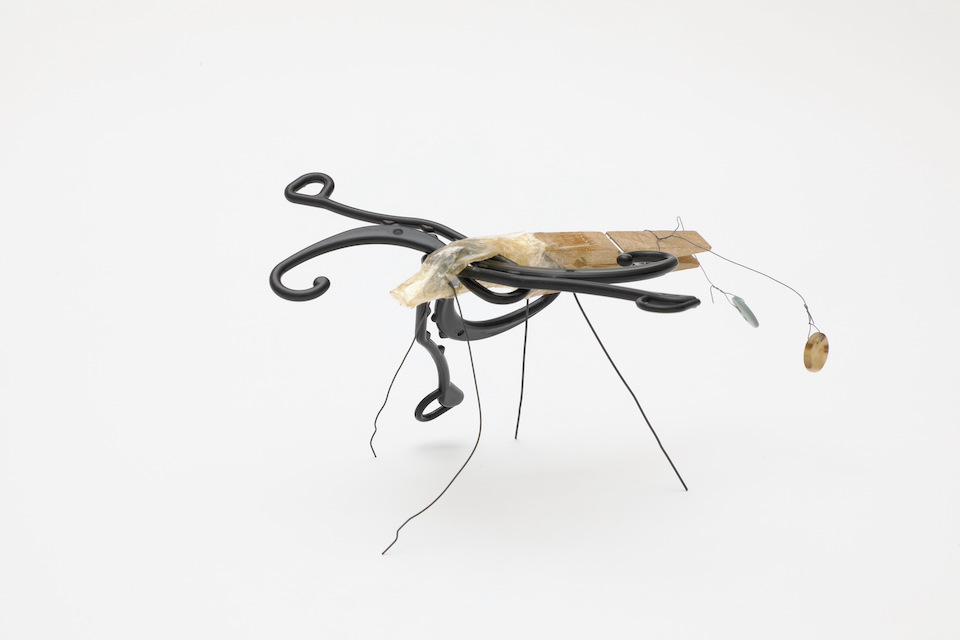
“Grasshopper” / 150×150×40mm / Buttons (plastic), wire, clothespin (wood, metal), spoon (plastic), socks hangers (plastic), cellophane tape / 1999 / Collection of The Nippon Foundation
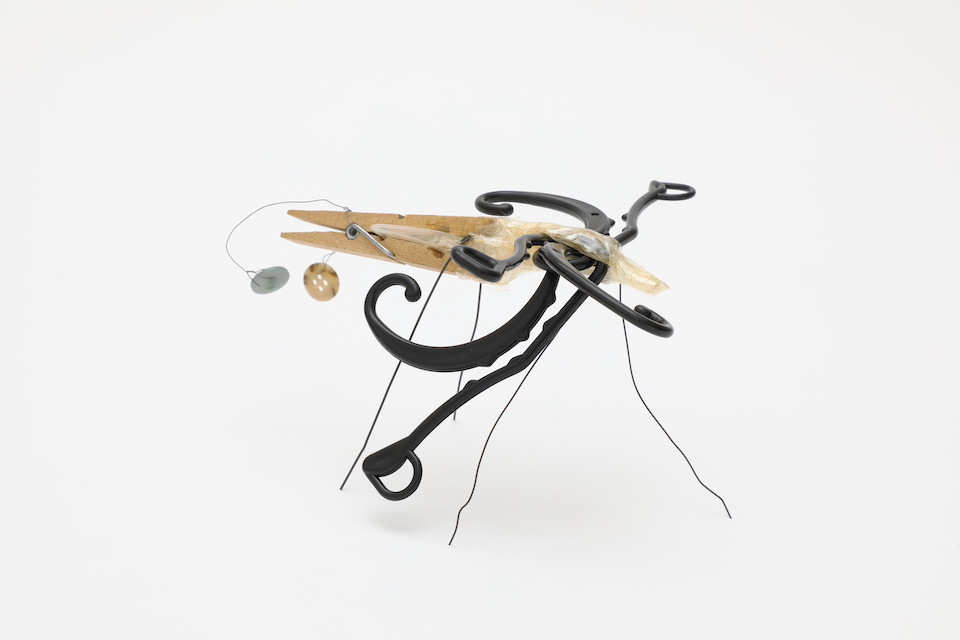
“Grasshopper” / 150×150×40mm / Buttons (plastic), wire, clothespin (wood, metal), spoon (plastic), socks hangers (plastic), cellophane tape / 1999 / Collection of The Nippon Foundation
Not even the Polish scientist knew this.
Then, several years after the war was over, suddenly, one was found. At a farmer’s house in rural Poland. Wondering about a random screeching noise coming from a window, the farmer’s wife found it.
And now we arrive at the present day.
The things are hugely popular in pet shops!
The reason why is because people in the present day are often under attack by things like radiation and pandemics and so on which have no real physical form.
In an age when what is causing so much unpleasantness is hard to understand, something whose unpleasantness can be understood at a glance and, moreover, which can be picked up with your hand became wildly popular. That’s why every home now has one of these evolved Scratchers.
This isn’t something just happening in Poland; Scratchers are a global fad. Their popularity in Brazil, in particular, is astounding.
They are actually quite docile, and they don’t need to be fed. They also don’t reproduce, so they can’t be bred en masse. Actually, it’s not known what powers them, but it is known that if put on some glass, they will scratch on it in a conditioned reflex. Normally they just sit there doing nothing. But they begin moving when stuck to a piece of glass.
I suppose the fact they aren’t normally unpleasant is one of the reasons for their popularity. They’re always docile and well-behaved. But the moment they are put on a windowpane, they become unpleasant, making a screeching noise. But the reason why they are unpleasant is eminently clear, so you can immediately stop it. They are also popular because they provide the sense of satisfaction and achievement received from eliminating something unpleasant.
But it’s ironic. The Windowpane Scratchers were created out of a desire to beat Hitler, but they spread around the globe and became so popular when the whole world was suffering under a pandemic.
It was actually only recently found out, but it seems that while the Window Scratchers caused the Nazis to move into basements to escape them, their awful sound never bothered Hitler himself. That’s right; Hitler was so engrossed in his own speeches, he never noticed. In the end, they were never even a nuisance to him.
The window-cutting machine, the cleaning machine, and the machine which transported them, however, went unrewarded. These three didn’t evolve. They were an evolutionary dead end. A shame they worked so hard.
Looking back now, they might seem superfluous or a waste. Perhaps they lacked something or perhaps too much thought was put into them; I don’t know, but at any rate, I guess they weren’t practical. But that’s what history’s all about, I suppose.
The evolution of the Scratchers, however, was marvelous.
They had something like a tactile sense, you know. They could use this to detect whether an enemy approached or whether there was a window there. And the subtlety of their legs. These legs are what produced the scratching, screeching sound which was so unpleasant to everyone. It wouldn’t work if they were any fatter, or thinner. They are directly descended from the unpleasant legs which failed to menace Hitler. Their size is unchanged. If anything, they’ve become slightly lighter in weight. Their feet have evolved into something like those of a water strider, enabling them to climb up things even on rainy days.
That reminds me; YASHIMA Koichi, the artist who actually made these works, created them in secret because he was told not to pick up things on the way to and from his center. Being told not to do something makes you want to do it, doesn’t it? I mean, Adam took a bite of the apple because he was told not to eat it.
Prohibition can be a source of creation, eh?
Issey Ogata’s Wildly Imaginative Art Appreciation Techniques
As actor, playwright, and director of his one-man show, Issey Ogata brings new worlds to life every day. We asked him for tips on having fun with the power of unfettered imagination.
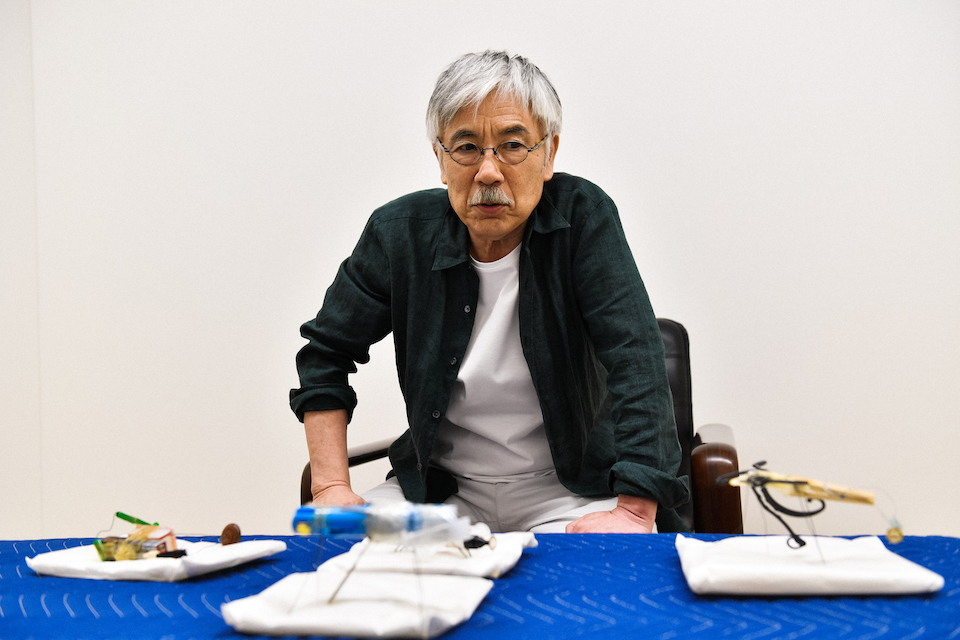
Dig down and expose the world for how rich of a place it is. The more works of art there are, the deeper one can dig into the world.
The fun of engaging in wild imagination is that you can look at the world right in front of you upside down, stare at it from below, and gaze at it from a different perspective.
And the trigger for this is works of art. Works of art encountered in a series, in particular, have the power to rock your foundations.
We tend to think the world as we see it now to be all that there is.
That world, however, changes depending on where we live, our environment, and of course the time period.
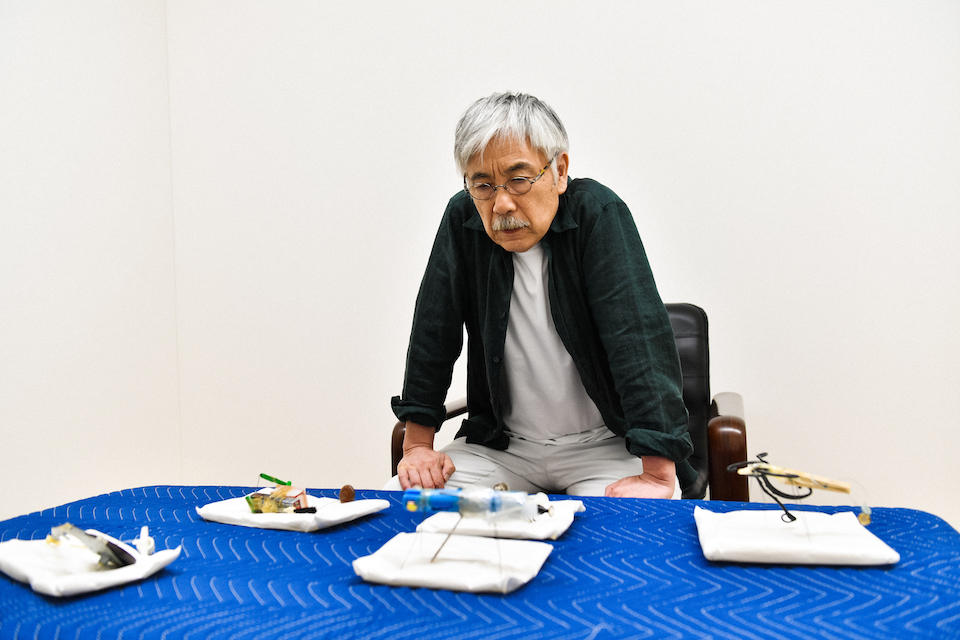
And it is works of art which become the trigger which produces this realization.
They have that kind of amazing power.
And the moment you realize that, the world becomes a rich place.
Because the world in front of you is not some idle, one-dimensional place.
The joy of further misunderstanding an already misunderstood world; to put it another way, you might called it “digging into and exposing” the world.
Works of art like this expose the depths of the world.
That’s why there’s value in digging into reality. There isn’t just one reality that can be dug up; there are as many realities to unearth as there are people to engage in wild imaginings, as there are works of art.
Dig into the world just a little bit and you’ll realize how big of a place it is, and once you experience the thrill of digging into it, you won’t be able to go back.
You’ll find the world can be dug into like this, or more like that; the number of ways is endless. As if tearing things away with steel claws, reality can be endlessly dug into and exposed.
The world which we can see now is not all there is.
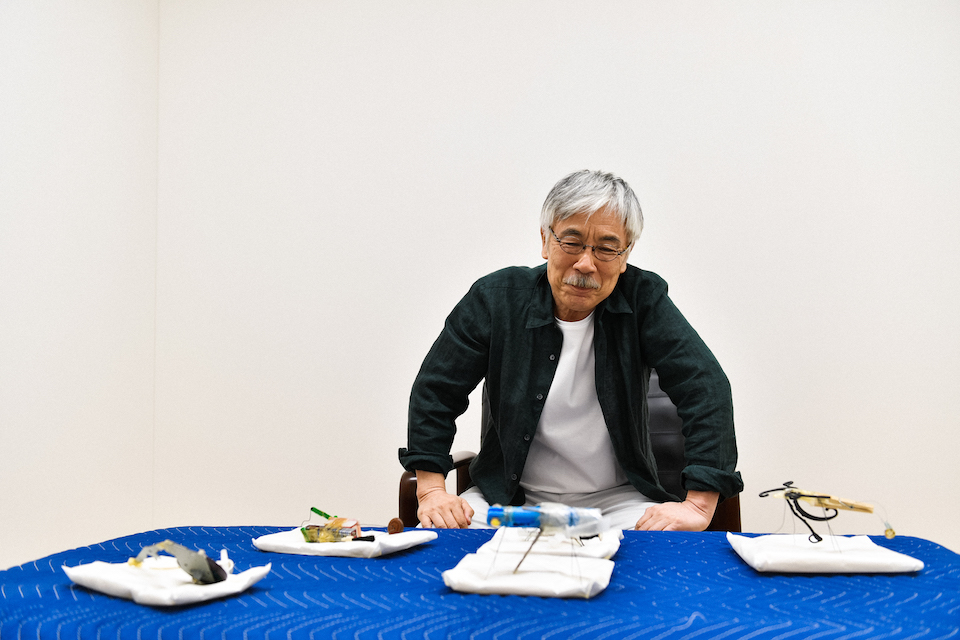
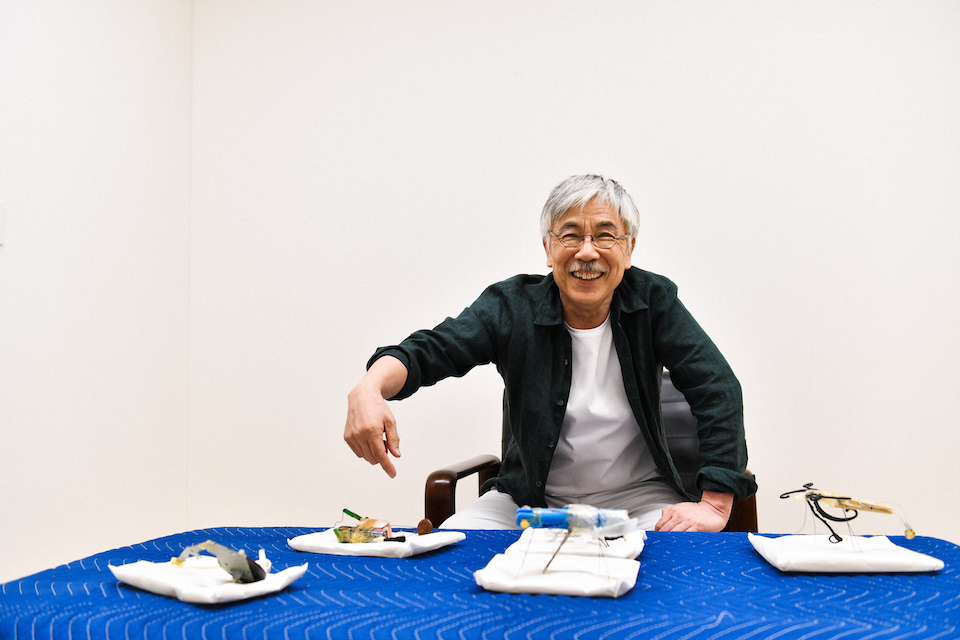
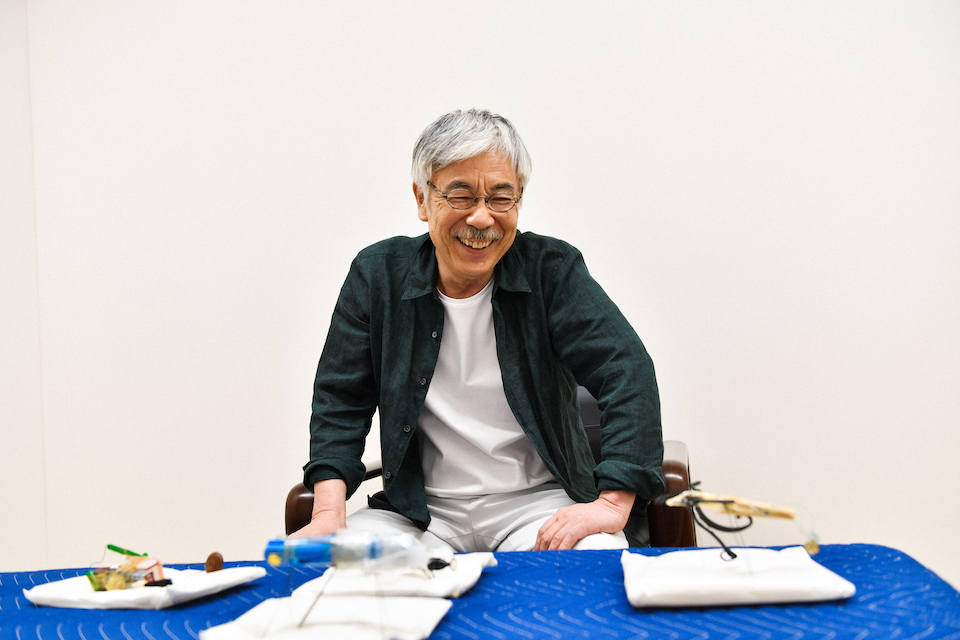
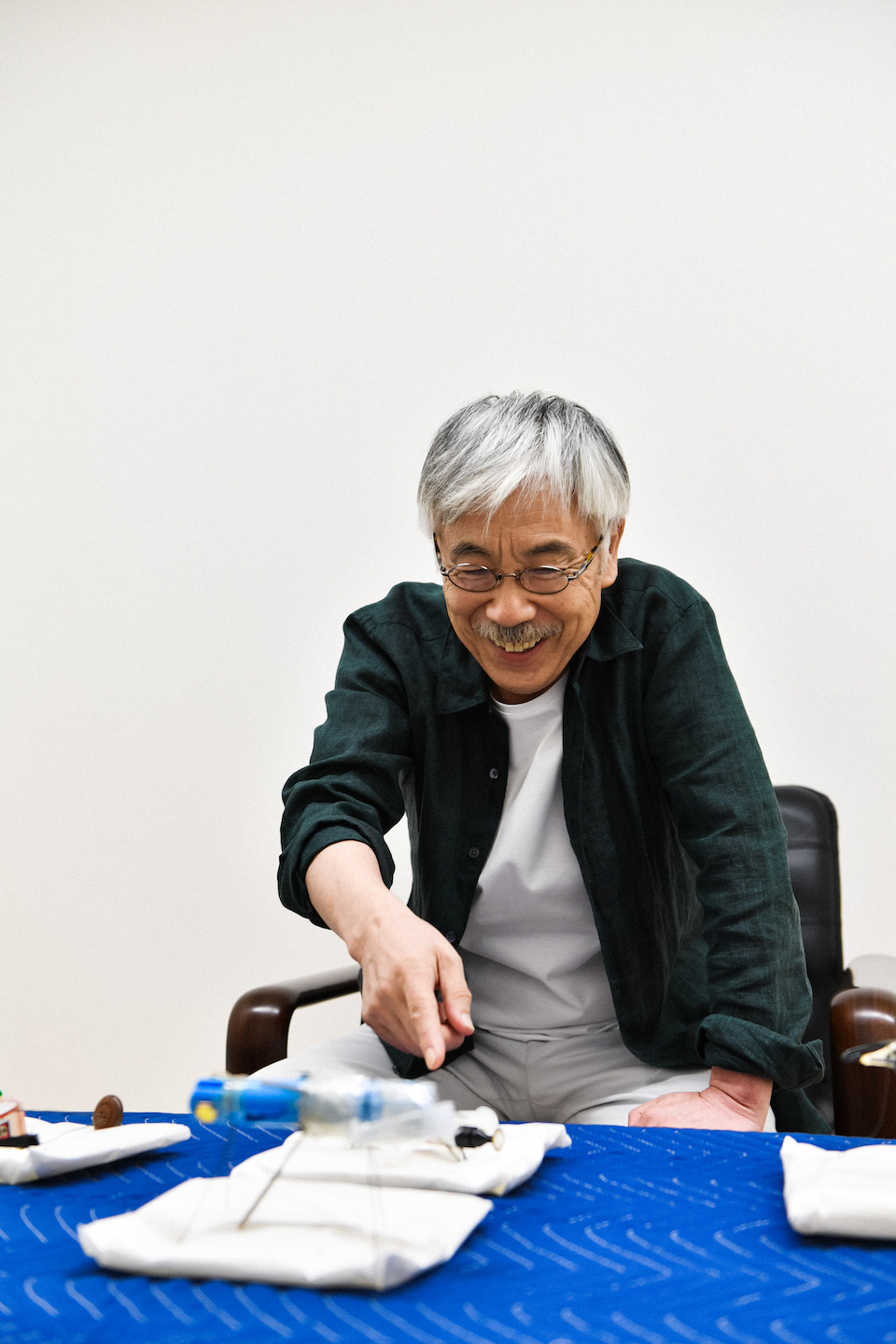
[Corporation] HILLTOP HOTEL
